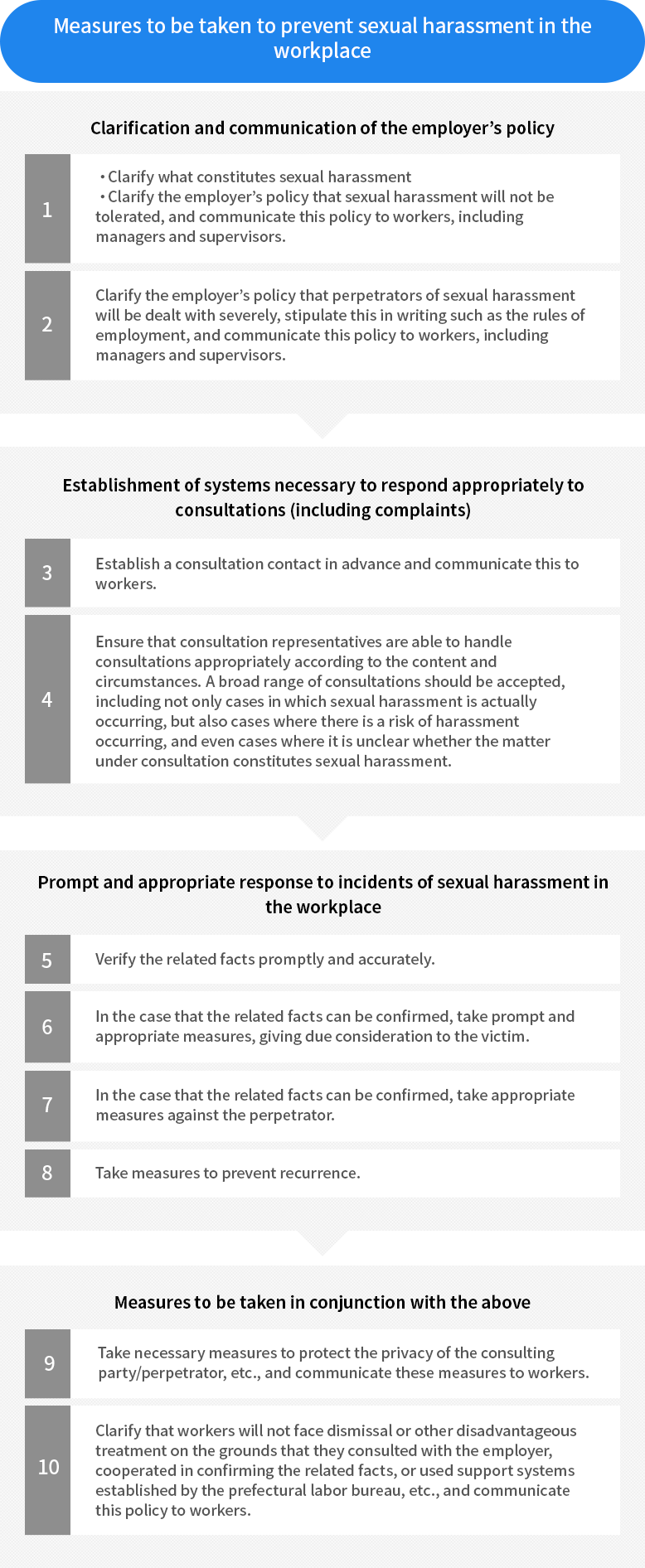What Is Sexual Harassment in the Workplace?
Article 11 of the Equal Employment Opportunity Act requires employers to take preventive measures against sexual harassment in the workplace.
With the recent amendment of the law, measures to prevent sexual harassment now include the prohibition of disadvantageous treatment on the grounds that the employee has consulted the employer regarding sexual harassment, as well as the requirement to cooperate with response measures when a worker of the company sexually harasses a worker of another company.
Article 11 (1) Employers shallestablish necessary measures in terms of employment managementto give advice to workers and cope with problems of workers, and take other necessary measures so thatworkers they employ do not suffer any disadvantage in their working conditions by reason of said workers’ responses to sexual harassment in the workplace, or in their working environments do not suffer any harm due to said sexual harassment.
(2) Employersshall not dismiss or otherwise treat a worker disadvantageously on the grounds that the worker has engaged in consultation as set forth in the preceding paragraph or has stated facts when cooperating with the response to said consultation.
(3) Employersshall endeavor to respond to requests from other employers for cooperation necessary in implementing measures set forth in paragraph 1 taken by the employer concerned.
<Equal Employment Opportunity Act (excerpt)>
Sexual harassment in the workplace refers to a situation in which aworker*1 suffers a disadvantage in terms of working conditions due to the worker’s response tolanguage or behavior of a sexual natureoccurring in theworkplace*2 against the will of the worker or a situation in whichlanguage or behavior of a sexual natureis detrimental to the working environment.
*1 For a definition of what constitutes a “worker,” see this link.
*2 For a definition of what constitutes a “workplace,” see this link.
What Is “Language or Behavior of a Sexual Nature”?
Language or behavior that is related to sexual matters.
Examples of language/behavior of a sexual nature
(1) Language of a sexual nature
Asking about sexual facts, spreading information (rumors) of a sexual nature, sexual jokes or teasing, persistent invitations to dinner or a date, sharing personal sexual episodes, etc.
(2) Behavior of a sexual nature
Forcing a sexual relationship, unnecessary physical contact, distributing or displaying obscene images, indecent assault, etc.
Persons using language/behavior of a sexual nature
Includes not only employers, managers, and colleagues, but also other employers such as business partners or their workers, as well as customers, patients or their families, students at a school, etc.
Both men and women can be the perpetrator or the victim, and sexual harassment applies not only to harassment of the opposite sex, but also to harassment of the same sex.
Regardless of the sexual orientation or gender identity of the victim, if “language or behavior of a sexual nature” is involved the act constitutes sexual harassment.
Key points regarding measures that employers are required to implement under guidelines.
The measures thatemployersshould take to prevent sexual harassment in the workplaceare as follows.
*Employers must implement these measures without fail.







